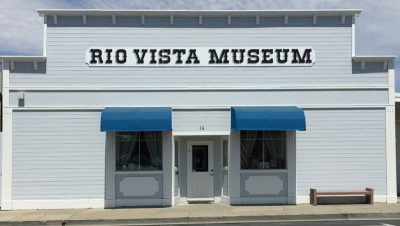Early Rio Vista History
In 1844 General John Bidwell, a naturalized citizen of Mexico, petitioned for a land grant on the Sacramento River, from Governor Micheltorena. The subsequent Los Ulpinos Land Grant included 17,724 acres. In 1848 the Mexican government signed California over to the United States government.
On December 3, 1855 John Bidwell’s 17,752 acre land grant known as “Los Ulpinos” was sold off in lots, to the highest bidder. This sale took place on the steps of the Benicia Courthouse. Among those who purchased lots was a gentleman by the name of N.H. Davis. Colonel Davis purchased six various lots, for a grand total of $440.
Now that Colonel Davis owned several lots, from the December sale, it was time to do something with the land. He had bought this acreage with the intent to subdivide part of the land into a town, near the Patwin Indian village, of “Hale Che Muk”. In the fall of 1857 he came to his new land and surveyed a plat, on lot no. 3, for a town. The site that he chose for the settlement was approximately one mile below the mouth of Cache Slough. It was called Los Brazos del Rio (Arms of the River) because it was situated so near three branches of the Sacramento.
During the next five years a number of buildings were erected, at the settlement. The first building to be erected was the home of Col. Davis.
In 1858 a post office was approved with the provision that the name of the settlement be changed. “Vista del Rio” was agreed upon, and used for a short time.
Mrs. Kirkpatrick, wife of Charles the postmaster, decided that a new name should be given to the place and chose “Rio Vista” (La Vista del Rio, in correct Spanish), which means “River View”. This new name was quickly adopted. For the next five years Rio Vista was a thriving village. The year 1861 proved to be the hardest winter that the Rio Vista settlement had encountered. The fall had been a hard one and the winter had brought high winds and heavy rains.
During the final days of December 1861, the waters rose so high that they washed away many of the smaller buildings in the Rio Vista settlement. But these villagers were a seasoned close-knit group who had helped one another through the hardships, which they had endured during the previous years. Those, whose property was lost, were quickly brought into the homes of the more fortunate. As the townspeople watched nature take its course, they realized that there was little or nothing that they could do to prevent the damage from continuing.
The height of these storms arrived on January 9, 1862. It was on this day that a great storm hit the delta town, bringing with it a fierce wind from the southeast and a heavy surplus of rain. This lethal combination of the wind and the rain caused the river to rise up over the banks and into the town. The floodwaters were as high as twelve feet at the foot of Main Street, and before long the entire town was under water.
In March of 1862 four men, Samuel R. Perry, John M. Sidwell, William K. Squires, and Issac Dunham, from the former Rio Vista settlement, went to see Mr. Joseph Bruning. Bruning was a wealthy rancher, who lived a league down river, on a higher plat of the land grant, located on an upper edge of the Montezuma Hills. Bruning had previously been in the hotel business in San Francisco, when due to ill health he purchased land in the Los Ulpinos grant, around 1858. The purpose of this visit was to ask Bruning for a plot of land on which to rebuild the Rio Vista settlement. Mr. Bruning granted their request and gave land on the northeastern part of his property. Accordingly Mr. Bruning surveyed and recorded the town plat of “New Rio Vista” in 1862. T.J. McWorthy, who then owned property, adjacent to the northern edge of Bruning’s, also surveyed and recorded an addition to the town. It was then decided that Main Street would be chosen as the line of division between the two ranches. From this point in time Rio Vista began to grow.
By Phil Pezzaglia
